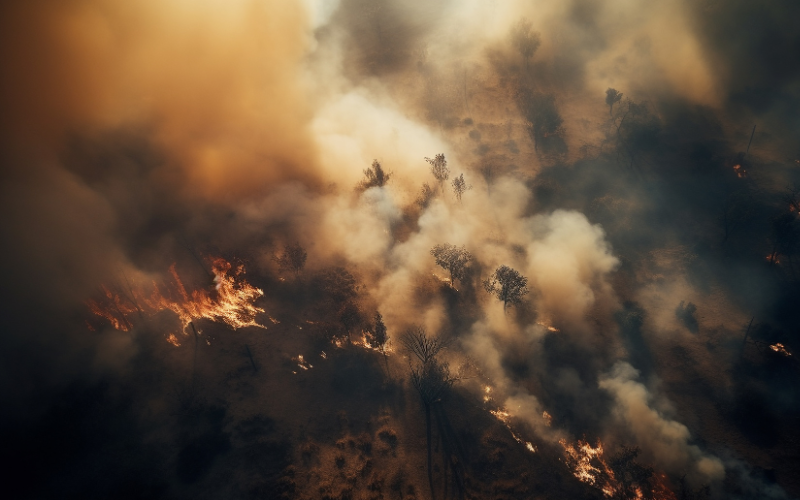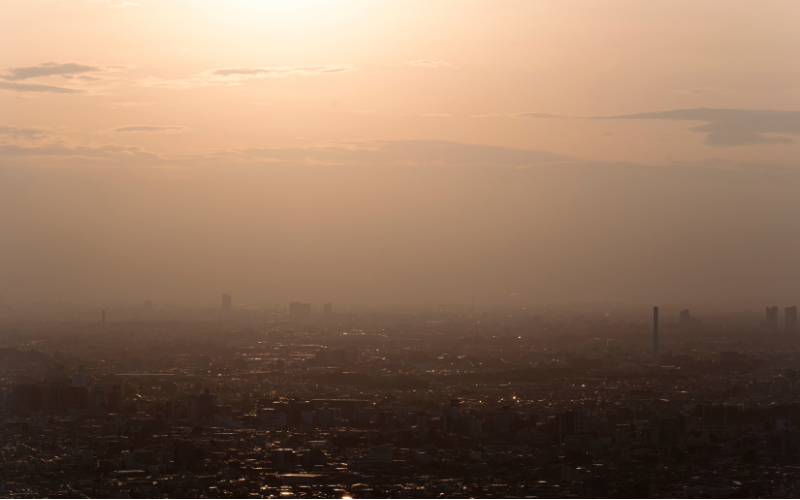
Exploring the Long-Term Health Impacts of Wildfire Smoke Exposure
Wildfires are a natural part of many ecosystems, but their increasing frequency and intensity are causing significant health concerns. If you’ve ever been close to a wildfire, you know the immediate effects: the acrid smell, the haze, and the irritation in your throat and eyes. But what about the long-term health impacts? In this blog, we'll explore what wildfire smoke exposure is, how long it lingers in the air, the long-term health effects, and how to protect yourself effectively, especially using Cambridge Mask Co’s smoke masks.
What is Wildfire Smoke Exposure?

Wildfire smoke is a complex mixture of gases and fine particles produced when wood and other organic materials burn. It contains a variety of pollutants, including carbon monoxide, volatile organic compounds (VOCs), and fine particulate matter (PM2.5). The tiny particles in PM2.5 are particularly concerning as they can penetrate deep into the lungs and even enter the bloodstream.
What is in Wildfire Smoke, and Why is it Dangerous?
Understanding the composition of wildfire smoke is key to comprehending its health risks. Here are some of the main components:
Particulate Matter (PM)
Wildfire smoke contains a high concentration of particulate matter, especially PM2.5. These fine particles are about 2.5 micrometers in diameter or smaller, allowing them to penetrate deep into the lungs and even enter the bloodstream. PM2.5 is linked to respiratory and cardiovascular problems and can exacerbate existing conditions like asthma and bronchitis.
Gases
Smoke from wildfires releases various harmful gases, including carbon monoxide, nitrogen oxides, and volatile organic compounds (VOCs). Carbon monoxide can interfere with the body’s ability to transport oxygen, leading to dizziness, confusion, and even death at high concentrations. Nitrogen oxides and VOCs contribute to the formation of ground-level ozone, a harmful air pollutant.
Toxic Chemicals
Wildfire smoke can contain a range of toxic chemicals, including formaldehyde, benzene, and polycyclic aromatic hydrocarbons (PAHs). These substances are known carcinogens and can increase the risk of developing cancer with prolonged exposure.
Heavy Metals
Depending on what is burning, wildfire smoke can also contain heavy metals like lead and mercury, which can have severe health impacts, particularly on the nervous system and kidneys.
How Long is Wildfire Smoke Present in the Air After a Wildfire?
The duration that wildfire smoke remains in the air varies based on several factors, including the size of the fire, weather conditions, and topography. Generally, smoke can linger in the atmosphere for days to weeks after the fire has been extinguished. Wind patterns can carry smoke over long distances, affecting air quality hundreds or even thousands of miles away from the fire site.
Understanding AQI During a Wildfire and Why You Should Wear a Mask
What is AQI?
The Air Quality Index (AQI) is a tool used to communicate how polluted the air currently is or how polluted it is forecast to become. The AQI ranges from 0 to 500, with higher values indicating worse air quality. It considers various pollutants, including ground-level ozone, particulate matter, carbon monoxide, sulfur dioxide, and nitrogen dioxide.
AQI Levels and Health Implications
- 0-50 (Good): Air quality is considered satisfactory, and air pollution poses little or no risk.
- 51-100 (Moderate): Air quality is acceptable; however, some pollutants may be a concern for a very small number of people who are unusually sensitive to air pollution.
- 101-150 (Unhealthy for Sensitive Groups): Members of sensitive groups may experience health effects. The general public is less likely to be affected.
- 151-200 (Unhealthy): Everyone may begin to experience health effects; members of sensitive groups may experience more serious health effects.
- 201-300 (Very Unhealthy): Health alert: everyone may experience more serious health effects.
- 301-500 (Hazardous): Health warnings of emergency conditions. The entire population is more likely to be affected.
During a wildfire, AQI levels can quickly rise into the unhealthy or hazardous range, necessitating precautions.
Why Wear a Mask?
When the AQI indicates poor air quality due to wildfire smoke, wearing a mask is essential to protect your respiratory health. Masks designed for smoke protection, like those from Cambridge Mask Co, can filter out the fine particles and harmful gases in wildfire smoke, reducing your exposure and safeguarding your health.
What are the Long-Term Effects of Smoke Exposure?

The immediate effects of wildfire smoke exposure, such as eye and throat irritation, coughing, and shortness of breath, are well-known. However, prolonged or repeated exposure can have serious long-term health impacts:
1. Respiratory Issues
Extended exposure to wildfire smoke can lead to chronic respiratory problems. Conditions such as asthma and chronic obstructive pulmonary disease (COPD) can be exacerbated, and there is an increased risk of developing lung infections and bronchitis.
2. Cardiovascular Problems
Fine particulate matter (PM2.5) from wildfire smoke can enter the bloodstream and contribute to cardiovascular issues. Studies have shown an increased risk of heart attacks, strokes, and heart failure in populations exposed to wildfire smoke.
3. Cancer Risk
The presence of carcinogenic compounds in wildfire smoke, such as benzene and formaldehyde, raises concerns about long-term cancer risk. Prolonged exposure increases the likelihood of developing cancers, particularly lung cancer.
4. Mental Health Effects
Experiencing wildfires and their aftermath can lead to significant mental health issues, including anxiety, depression, and post-traumatic stress disorder (PTSD). The stress of potential property loss and health risks can have lasting psychological impacts.
How Can We Protect Ourselves Against Wildfire Smoke?
Given the potential long-term health impacts of wildfire smoke exposure, taking preventive measures is crucial. Here are some steps to protect yourself:
1. Stay Informed
Monitor air quality reports and wildfire updates in your area. Websites like AirNow provide real-time air quality information. Being aware of the AQI can help you decide when to take extra precautions to protect your health.
2. Stay Indoors
When smoke levels are high, stay indoors with windows and doors closed. Use air purifiers with HEPA filters to reduce indoor air pollution. Creating a clean air room in your home can provide a refuge from smoky conditions.
3. Use Smoke Masks
Wearing a high-quality smoke mask can significantly reduce your exposure to harmful particles. Masks with a good fit and advanced filtration technology are particularly effective.
4. Limit Outdoor Activities
Avoid strenuous outdoor activities when air quality is poor. This reduces the amount of smoke you inhale and minimizes the risk of respiratory and cardiovascular issues.
5. Prepare Your Home
Seal gaps in windows and doors to prevent smoke from entering. Ensure your HVAC system has clean filters and consider using HEPA filters to improve indoor air quality. Having an emergency plan and kit can also be beneficial.
Cambridge Mask Co's Smoke Masks: The Perfect Protection Against Wildfire Smoke

When it comes to protecting yourself from wildfire smoke, not all masks are created equal. Cambridge Mask Co’s smoke masks are designed to provide the highest level of protection. Here’s why they stand out:
Advanced Filtration
Cambridge Mask Co’s masks are equipped with military-grade filtration technology. They filter out 99.6% of viruses, bacteria, and particulate matter, including PM2.5, making them ideal for smoke protection. This advanced filtration ensures that even the finest particles are trapped, significantly reducing your exposure to harmful pollutants.
Comfortable and Breathable
The masks are designed for comfort, with adjustable straps and a snug fit to ensure no gaps. This makes them suitable for long-term wear, crucial during extended periods of smoke exposure. The breathable material helps prevent overheating and discomfort, allowing you to wear the mask for extended periods without issue.
Reusable and Durable
Unlike disposable masks, Cambridge Mask Co’s products are reusable and can be washed multiple times without losing their effectiveness. This makes them a cost-effective and environmentally friendly option. The durability of these masks means they can be a reliable part of your emergency kit for years to come.
Tested and Trusted
Cambridge Mask Co’s masks meet rigorous safety standards and have been tested to ensure they provide reliable protection. They are trusted by individuals and healthcare professionals worldwide. This reputation for quality and reliability makes them a top choice for anyone looking to protect themselves from the harmful effects of wildfire smoke.
Conclusion
Wildfire smoke exposure is a growing concern with significant long-term health impacts. By understanding the risks and taking proactive measures, you can protect yourself and your loved ones. Using high-quality smoke masks, like those from Cambridge Mask Co, is one of the best ways to reduce your exposure to harmful pollutants. Stay informed, stay indoors when necessary, and make sure you’re equipped with the best protection available.


